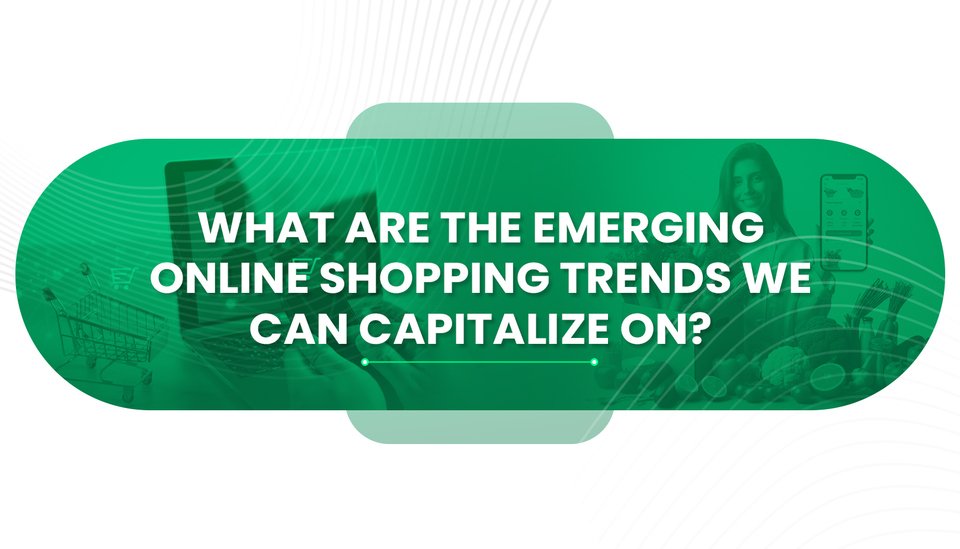
What Are the Emerging Online Shopping Trends We Can Capitalize On?

Ecommerce is evolving at a rapid pace, and businesses that fail to keep up risk falling behind. With global trends in e commerce shaping consumer expectations and behaviors, what are the key shifts that online retailers should leverage to stay ahead? Let’s explore some of the most promising trends shaping the future of online shopping and how businesses can capitalize on them.
1. How Is Augmented Reality Enhancing Online Shopping?
One of the biggest challenges in online shopping is the inability to physically interact with products before purchasing. Augmented Reality (AR) is changing the game by offering virtual try-ons and 3D product visualizations. Major brands like IKEA and Sephora are already using AR to help customers visualize products in real-life settings. How can businesses capitalize on this trend? Implement AR features in product pages, offer interactive previews, and integrate AR-powered virtual shopping assistants to improve the shopping experience.2. Is Voice Search Transforming the Way Consumers Shop?
With the increasing adoption of smart speakers, voice search is becoming a vital part of the ecommerce journey. Studies predict that 75% of U.S. households will own a smart speaker by 2025. Consumers are using voice assistants like Amazon Alexa and Google Assistant to search for products and even make purchases. What should businesses do? Optimize website content for voice search by focusing on conversational keywords and ensuring product descriptions are voice-friendly.3. Can AI and Personalization Create a Tailored Shopping Experience?
Artificial Intelligence (AI) is revolutionizing ecommerce by enabling hyper-personalized shopping experiences. AI-powered tools analyze customer data to provide tailored product recommendations, personalized emails, and automated chat support. How can businesses utilize AI effectively? Implement AI-driven product recommendations, chatbots for customer service, and predictive analytics to understand consumer buying patterns.4. How Does Data-Driven Personalization Improve Customer Loyalty?
Consumers expect brands to understand their preferences and offer relevant suggestions. A study by Google found that 72% of customers are more likely to be loyal to a brand that provides a personalized shopping experience. What steps can retailers take? Utilize customer data ethically to create a seamless omnichannel shopping experience, offer dynamic pricing, and implement personalized marketing campaigns.5. Why Is Chat Marketing the Future of Customer Interaction?
With advancements in AI, chatbots and messaging apps are becoming more human-like and effective in assisting shoppers. Brands that leverage chat marketing can provide real-time responses, product recommendations, and a more engaging experience. How can businesses use chat marketing? Integrate AI-powered chatbots on websites and social media channels to offer instant customer support and personalized shopping assistance.6. Is Mobile Commerce Still on the Rise?
Mobile commerce continues to dominate, with an estimated 62% of all ecommerce transactions expected to come from mobile devices by 2027. Consumers demand seamless, mobile-friendly shopping experiences. How can businesses adapt? Optimize ecommerce websites for mobile, enable one-click checkout, and invest in mobile payment solutions.7. Are Flexible Payment Options Increasing Conversions?
Today’s consumers expect a variety of payment methods, including digital wallets, cryptocurrencies, and buy now, pay later (BNPL) services. Studies show that 13% of shoppers abandon their carts due to a lack of preferred payment options. What’s the solution? Offer multiple payment methods, including PayPal, Apple Pay, and installment plans via providers like Klarna or Affirm.8. What Role Does Social Commerce Play in Online Shopping?
Social media platforms like Instagram, TikTok, and Facebook are no longer just for engagement—they’re now full-fledged shopping destinations. In 2025, an estimated 110.4 million people will make purchases through social media platforms. How can businesses take advantage? Use shoppable posts, leverage influencer marketing, and host live shopping events to drive direct sales from social media platforms.9. How Does Subscription-Based Shopping Foster Customer Retention?
Subscription services are reshaping online shopping, offering businesses a steady revenue stream while increasing customer retention. From curated fashion boxes to meal kits, the subscription economy is booming and is expected to reach $1.5 trillion by 2025. How can businesses implement this model? Introduce subscription-based product offerings and reward loyal customers with exclusive perks and discounts.10. Why Is Sustainability a Key Consideration for Modern Shoppers?
Today’s consumers are becoming more conscious of sustainability and ethical business practices. Over 70% of shoppers prefer brands that prioritize eco-friendly initiatives. How should brands respond? Use sustainable packaging, offer eco-friendly products, and be transparent about sourcing and environmental impact.11. Is B2B Ecommerce Changing the Way Businesses Operate?
B2B ecommerce is evolving, with businesses now expecting the same seamless digital experience as B2C consumers. Features like personalized pricing, bulk ordering, and digital self-service portals are becoming industry standards. How can B2B companies capitalize on this trend? Invest in modern ecommerce platforms with personalized customer portals and automated order management systems.12. How Can Businesses Determine Which Trends to Adopt?
With so many emerging trends, how do businesses know which ones to invest in? The answer lies in understanding customer needs, analyzing market data, and observing competitors. What are the key steps?- Keep up with industry publications and influencers.
- Leverage analytics tools to understand customer behavior.
- Gather direct feedback from customers through surveys and reviews.
- Evaluate competitor strategies and adapt accordingly.
- Consider the cost and ROI before implementing new trends.





